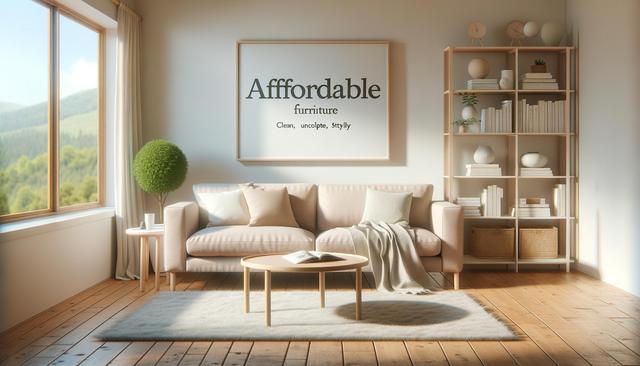Understanding What Makes Furniture Affordable
Affordable furniture goes beyond just low prices. It includes value for money, durability, functionality, and style. When shopping on a budget, it’s essential to evaluate what you’re getting for the price. Some pieces may have a higher upfront cost but offer better longevity, making them a smarter investment in the long run. Consider how often the furniture will be used and whether it meets your space and lifestyle needs. For example, a multi-use piece like a storage ottoman or a sleeper sofa can serve more than one purpose, saving space and money.
Affordability also varies depending on material choices. For instance, solid wood is often more expensive, but engineered wood or metal can deliver similar aesthetics at a lower cost. It’s helpful to compare materials and construction methods to get the most value while staying within your budget.
Best Places to Find Budget-Friendly Furniture
One of the keys to finding affordable furniture is knowing where to shop. While large retailers often offer seasonal sales, many other sources can provide excellent deals year-round. Here are a few options to consider:
- Online marketplaces: These often carry a wide range of new and secondhand items.
- Local thrift stores or consignment shops: Ideal for one-of-a-kind finds and vintage pieces.
- Warehouse sales and outlet centers: These can offer discounts on overstock or slightly damaged items.
- Direct-to-consumer brands: Often provide savings by cutting out the middleman.
In addition, community-based options such as neighborhood swap groups or online classifieds can be a goldmine for gently used furniture that others no longer need. With a little patience and research, you can discover unique and functional pieces at a fraction of the original cost.
Choosing Quality Without Overspending
Budget-friendly furniture doesn’t have to mean poor quality. There are several ways to spot well-made items that will last, even if they’re not the most expensive. Pay attention to details such as the type of joints used in construction—dovetail or mortise-and-tenon joints generally indicate sturdier pieces compared to staples or nails. Also, examine the finish and look for even surfaces and smooth edges.
When shopping online, customer reviews can offer valuable insights into the longevity and performance of a product. Look for reviews that mention long-term use or unexpected durability. It’s also wise to prioritize essential furniture first, such as a bed or dining table, and allocate more of your budget to those items, while finding more economical options for décor or accent pieces.
DIY and Upcycling: Creative Options for Budget Decor
If you’re open to a bit of creativity, DIY and upcycling can be rewarding ways to furnish your home affordably. Repurposing old furniture or giving a fresh coat of paint to a worn-out piece can transform it into something that fits your style without requiring a big spend. Many people find satisfaction and uniqueness in furniture they’ve customized themselves.
Here are some simple DIY ideas:
- Paint or stain wooden furniture for a new look.
- Add new hardware to dressers or cabinets for an updated style.
- Use fabric to reupholster chairs or make cushion covers.
- Build simple shelves or storage units using recycled wood or crates.
Upcycling also supports sustainability by reducing waste and giving older pieces a second life. It’s a practical choice for those looking to decorate responsibly while saving money.
Planning Your Furniture Budget Effectively
Planning ahead is essential when furnishing a space on a budget. Start by setting a total spending limit and breaking it down by room or item. Make a list of priorities and focus on the most functional pieces first. This approach helps avoid impulse purchases and ensures that key needs are met before spending on extras.
It also helps to consider timing. Shopping during off-seasons or around holiday sales can lead to better deals. Subscribing to newsletters or following your favorite furniture sources online can alert you to upcoming discounts or clearance events. Additionally, consider flexible payment options like layaway plans or interest-free financing, which can make higher-quality furniture more accessible without immediate financial strain.
By sticking to a thoughtful budget and being strategic about purchases, it’s entirely possible to create a comfortable and stylish living space that aligns with your financial goals.
Conclusion: Furnishing Smart for Less
Affordable furniture is not just about choosing the cheapest items—it’s about making informed decisions that balance cost, function, and quality. Whether you opt for secondhand finds, DIY projects, or strategically timed purchases from reputable retailers, you can furnish your home in a way that reflects your style without overspending. With the right planning and a bit of creativity, a well-furnished home on a budget is well within reach.




Leave a Reply